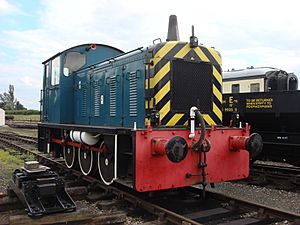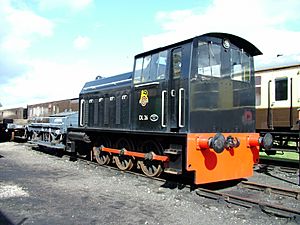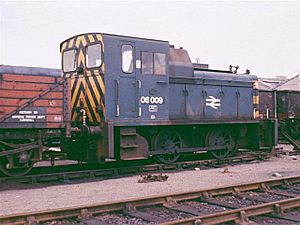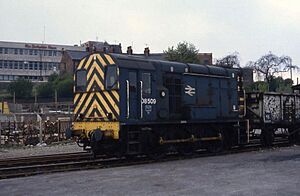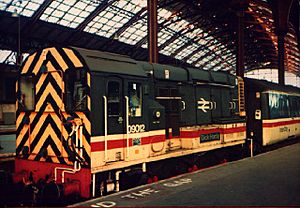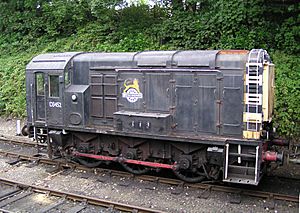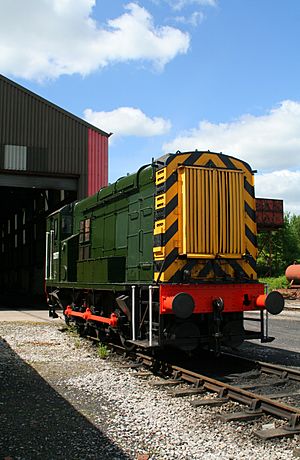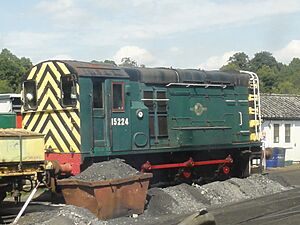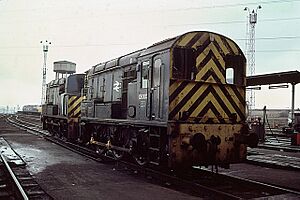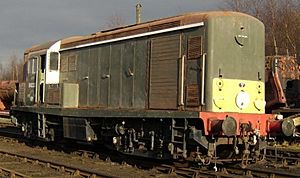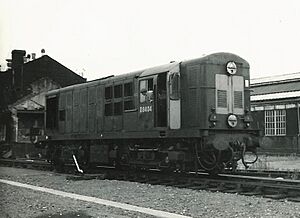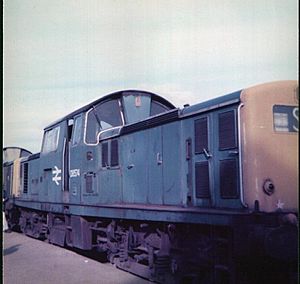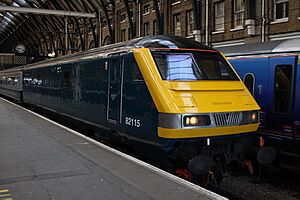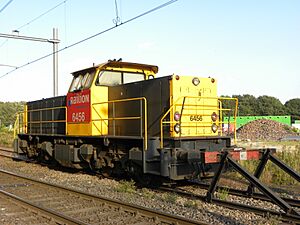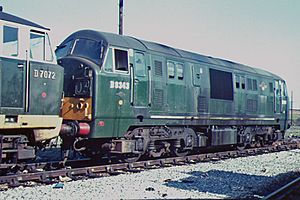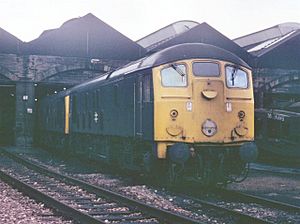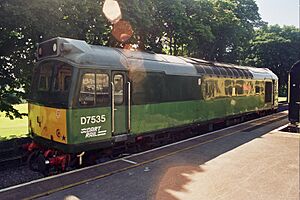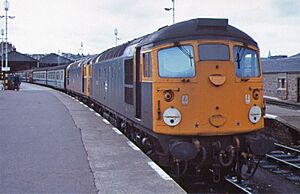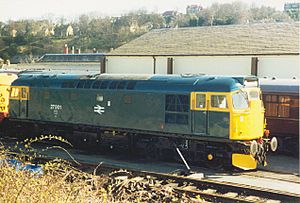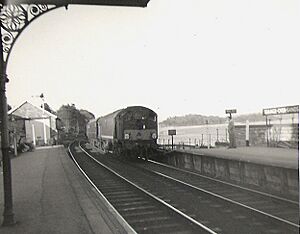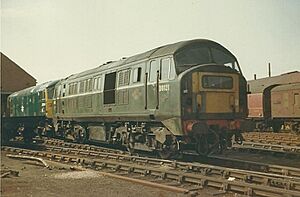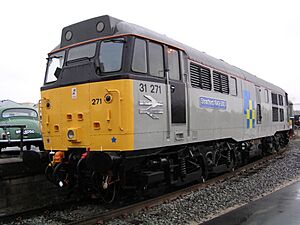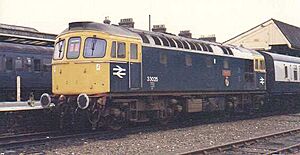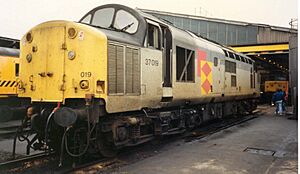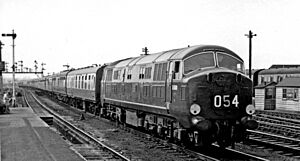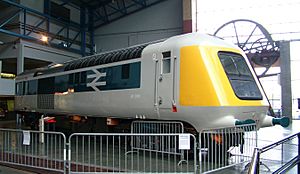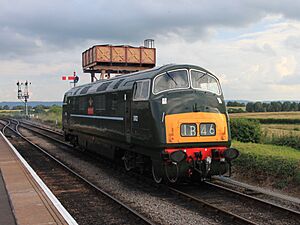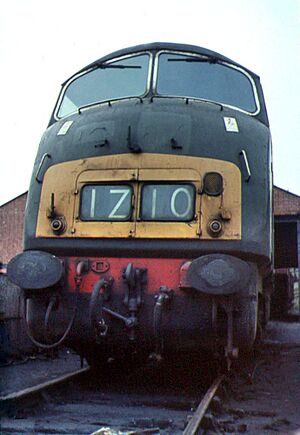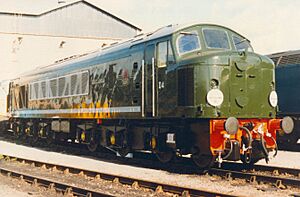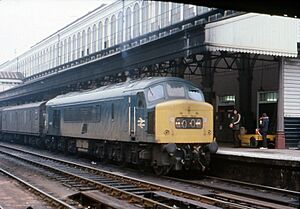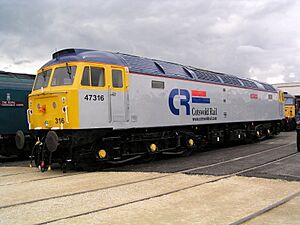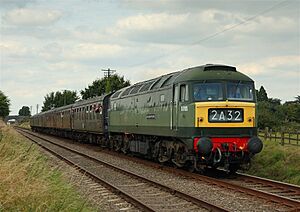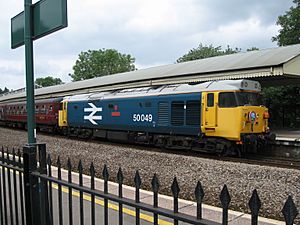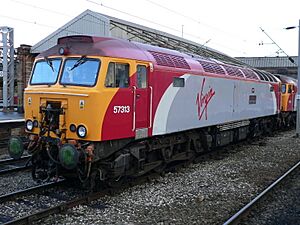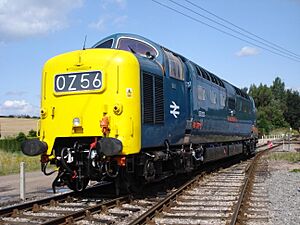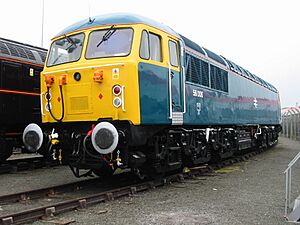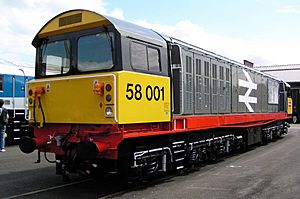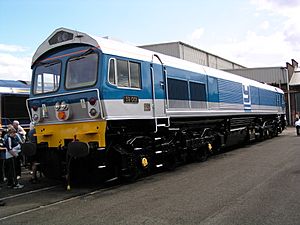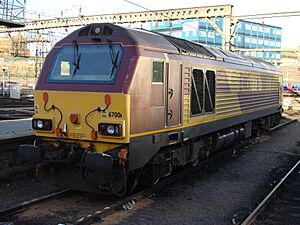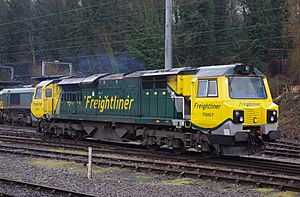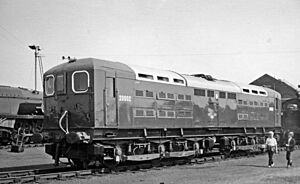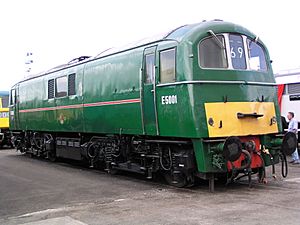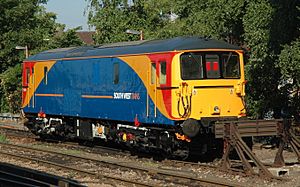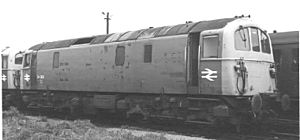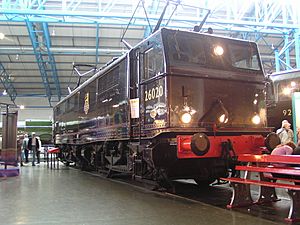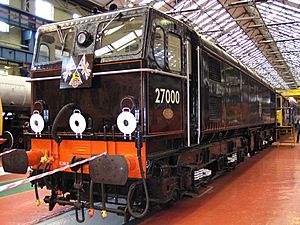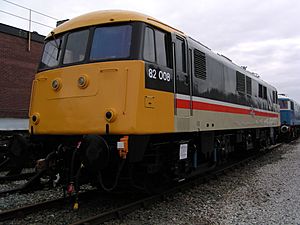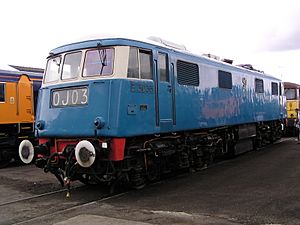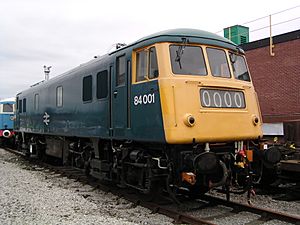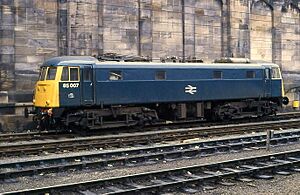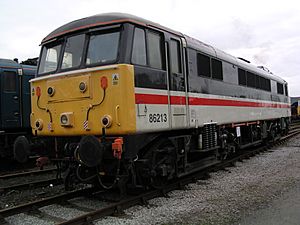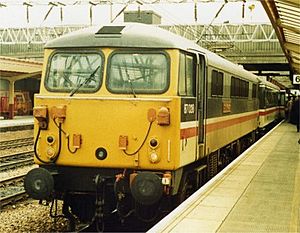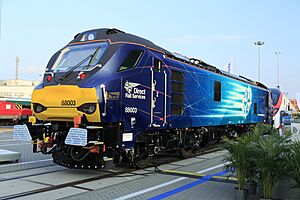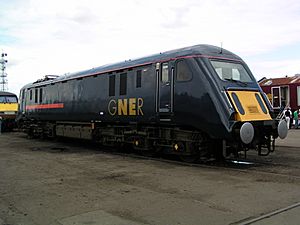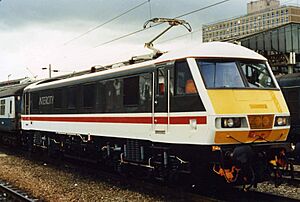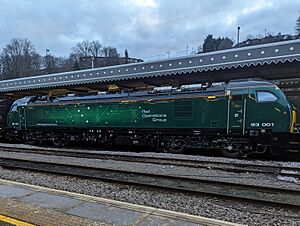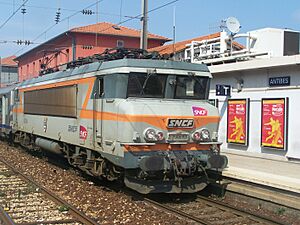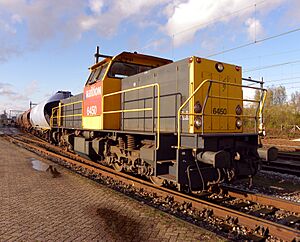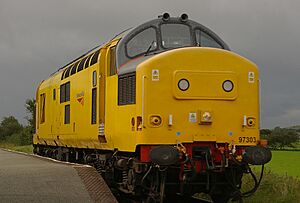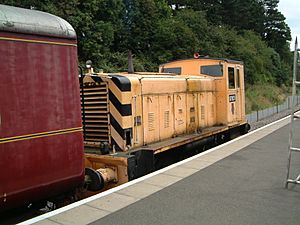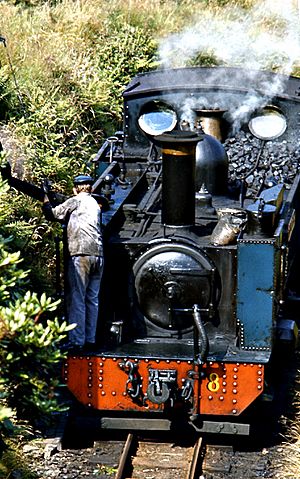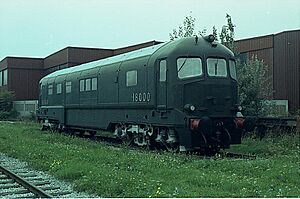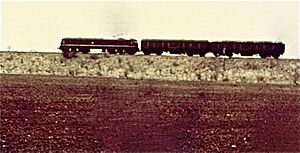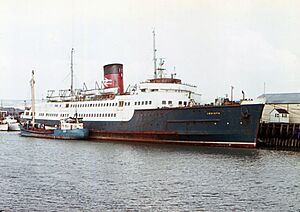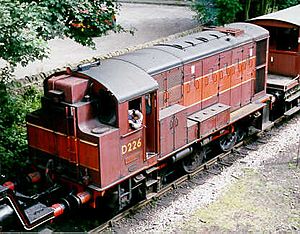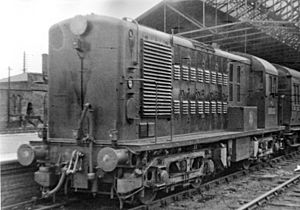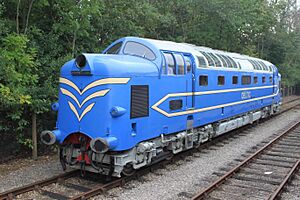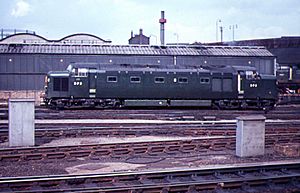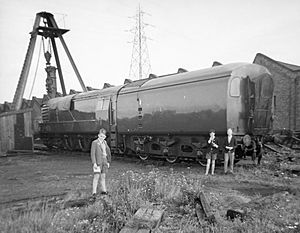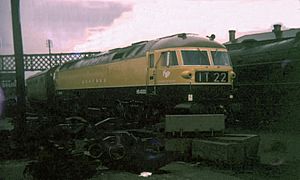List of British Rail modern traction locomotive classes facts for kids
This article is a list of all the different types of locomotives that have been used on the main railway lines in Britain since 1948. This includes trains that run on diesel, electricity, and even some special ones like gas turbine or petrol engines. Each type of train has a special code called a TOPS classification.
Contents
Diesel Locomotives: Powering the Rails
Diesel locomotives are trains that use a diesel engine to create power, either directly to the wheels or to generate electricity for motors. British Rail bought many different kinds of these trains.
Small Shunters: Under 300 Horsepower
Small shunters are like the busy little helpers of the railway. They are not very powerful, usually under 300 horsepower, but they are great for moving wagons and carriages around in small areas like train yards. Many of these smaller engines were used before the TOPS system was fully in place.
| TOPS Class | Built (Years) | How Many? | Engine Power | Notes |
|---|---|---|---|---|
| Class 01 | 1956–58 | 5 | 153 hp | These small shunters were used for light duties. |
| Class 02 | 1960–61 | 20 | 170 hp | Another group of small, hardworking shunters. |
| Class 03 | 1957–61 | 230 | 204 hp | This was a very common type of small shunter. Many were built! |
| Class 04 | 1952–62 | 142 | 204 hp | Some of these were even sent to Italy after they finished their work in Britain. |
| Class 05 | 1955–61 | 69 | 204 hp | These shunters were also quite popular. |
| Class 06 | 1958–60 | 35 | 204 hp | You might have seen one of these working in a train yard. |
| Class 07 | 1962 | 14 | 275 hp | These were a bit more powerful than some other small shunters. |
Large Shunters: 300–799 Horsepower
These shunters were bigger and stronger, able to move heavier trains and wagons around larger railway yards.
| TOPS Class | Built (Years) | How Many? | Engine Power | Notes |
|---|---|---|---|---|
| Class 08 | 1953–62 | 996 | 350 hp | This is the most common shunter ever built for British Rail! Many are still in use today. |
| Class 09 | 1959–62 | 26 | 350 hp | Some of these were actually rebuilt from Class 08 locomotives. |
| Class 10 | 1955–62 | 146 | 350 hp | These shunters were also very common. |
| Class 11 | 1945–52 | 136 | 350 hp | These were originally from the LMS railway company. |
| Class 12 | 1949–52 | 24 | 350 hp | These were ordered by the Southern Railway. |
| Class 13 | 1965 | 3 | 360 hp | These special shunters were rebuilt from Class 08s to work on hump shunting yards, pushing wagons over a small hill to sort them. |
Type 1 Locomotives: 800 – 1,000 Horsepower
These were the first main line diesel locomotives, used for lighter passenger and freight trains.
| TOPS Class | Built (Years) | How Many? | Engine Power | Notes |
|---|---|---|---|---|
| Class 14 (Teddy Bear) | 1964–65 | 56 | 700 hp | Nicknamed "Teddy Bears" because of their look, some were even sold to other countries. |
| Class 15 | 1957–61 | 44 | 800 hp | Some of these were later used as non-moving units to heat electric trains. |
| Class 16 | 1958 | 10 | 800 hp | All of these locomotives were eventually scrapped. |
| Class 17 (Clayton Type 1) | 1962–65 | 117 | 2× 450 hp | These had two smaller engines. Some were used for research. |
| Class 19 | 2018 | 1 | DVT | This was a special Mark 3 Driving Van Trailer rebuilt to power itself. |
| Class 20 | 1957–68 | 228 | 1,000 hp | These distinctive locomotives are still in use today! |
Type 2 Locomotives: 1,001 – 1,499 Horsepower
These were more powerful diesel locomotives, used for a wider range of passenger and freight services.
| TOPS Class | Built (Years) | How Many? | Engine Power | Notes |
|---|---|---|---|---|
| Class 21 (I) (NBL) | 1958–60 | 58 | 1,000 hp | Some of these were later rebuilt into Class 29 locomotives. |
| Class 21 (II) | 1991–2016 | 11 | 1,270-2,110 hp | These are modern diesel locomotives, still in use. |
| Class 22 (Baby Warship) | 1959–62 | 58 | 1,000-1,100 hp | Nicknamed "Baby Warships," these were all withdrawn by 1972. |
| Class 23 (Baby Deltic) | 1959 | 10 | 1,100 hp | Known as "Baby Deltics," one was used for research for a while. |
| Class 24 | 1958–61 | 151 | 1,160 hp | A very common type of diesel locomotive. |
| Class 25 | 1961-67 | 323 | 1,250 hp | Another very large class of diesel locomotives. |
| Class 26 | 1958 | 47 | 1,160 hp | These were used for many years on British railways. |
| Class 27 | 1961–62 | 69 | 1,250 hp | These were used for both passenger and freight trains. |
| Class 28 | 1958–59 | 20 | 1,200 hp | One of these was used by the Research Division for testing. |
| Class 29 | 1965–1967 | 20 | 1,350 hp | These were rebuilt from the earlier Class 21 locomotives. |
| Classes 30 & 31 | 1957-62 | 263 | 1,250-1,365 hp | Many of these are still in use today, showing how long-lasting they are! |
Type 3 Locomotives: 1,500–1,999 Horsepower
These powerful diesel locomotives were designed for heavier and faster trains.
| TOPS Class | Built (Years) | How Many? | Engine Power | Notes |
|---|---|---|---|---|
| Classes 33 & 34 | 1960–62 | 98 | 1,550 hp | Some of these are still in use with special railway companies. |
| Class 35 (Hymek) | 1961–64 | 101 | 1,700 hp | Known as "Hymeks," these were hydraulic locomotives. |
| Class 37 | 1960–65 | 309 | 1,750 hp | A very popular and long-lasting class, many are still in use. |
Type 4 Locomotives: 2,000–2,999 Horsepower
These were some of the most powerful diesel locomotives, used for express passenger services and heavy freight.
| TOPS Class | Built (Years) | How Many? | Engine Power | Notes |
|---|---|---|---|---|
| Class 40 | 1958–62 | 200 | 2,000 hp | These were a common sight on main lines for many years. |
| Class 41 (I) (Warship) | 1958–59 | 5 | 2× 1,000 hp | These "Warship" class locomotives were withdrawn before the TOPS system started. |
| Class 41 (II) | 1972 | 2 | 2,250 hp | These were the first power cars for the Prototype HST (High Speed Train). |
| Class 42 (Warship) | 1958–61 | 38 | 2× 1,135 hp | Another "Warship" class, some were used for testing. |
| Class 43 (I) (Warship) | 1960–62 | 33 | 2× 1,100 hp | These were also part of the "Warship" family. |
| Class 43 (II) | 1975–82 | 197 | 1,770 hp | These are the famous power cars for the InterCity 125 HST sets, many are still in use! |
| Class 44 (Peak) | 1959–60 | 10 | 2,300 hp | These were the first of the "Peak" family of locomotives. |
| Class 45 (Peak) | 1960–63 | 127 | 2,500 hp | A very large group of "Peak" locomotives. |
| Class 46 (Peak) | 1961 | 56 | 2,500 hp | More "Peak" locomotives, some were used for special departmental work. |
| Class 47 | 1962–68 | 512 | 2,750 hp | This is the most numerous class of main line diesel locomotive in Britain! Many are still in use. |
| Class 48 | 1965–66 | 5 | 2,650 hp | These were later rebuilt and became part of the Class 47 family. |
| Class 50 | 1967–68 | 50 | 2,700 hp | These powerful locomotives are still in use by some freight companies. |
| Class 52 (Western) | 1961–1964 | 74 | 2 x 1,350 hp | Known as "Westerns," these had a unique look and sound. |
| Class 53 (Falcon) | 1961 | 1 | 2,880 hp | This was a special prototype locomotive, only one was built. |
| Class 57 | 1997–2004 | 33 | 2,580 hp | These were rebuilt from Class 47 locomotives and are still in use. |
Type 5 Locomotives: Over 3,000 Horsepower
These are the most powerful diesel locomotives, designed for the heaviest and fastest trains.
| TOPS Class | Built (Years) | How Many? | Engine Power | Notes |
|---|---|---|---|---|
| Class 55 (Deltic) | 1961–62 | 22 | 2× 1,650 hp | Famous for their unique sound and speed, these were very popular. |
| Class 56 | 1976–84 | 135 | 3,250 hp | Many of these are still in use for freight trains. |
| Class 58 | 1983–87 | 50 | 3,300 hp | Some of these were later used in other countries like France and Spain. |
| Class 59 | 1985–95 | 15 | 3,300 hp | These powerful locomotives are still in use today. |
| Class 60 | 1989–93 | 100 | 3,100 hp | Designed for heavy freight, many are still in use. |
| Class 66 | 1998–2015 | 446 | 3,300 hp | This is a very common modern freight locomotive, still in use across Britain. |
| Class 67 | 1999–2000 | 30 | 3,200 hp | These are used for both passenger and freight duties and are still in use. |
| Class 68 | 2013–2017 | 34 | 3,800 hp | These modern locomotives are still in use. |
| Class 69 | 2020 (Planned) | 16 (planned) | – | These are planned to be rebuilt from Class 56 locomotives. |
| Class 70 (II) | 2009–2017 | 37 | 3,300 hp | These powerful freight locomotives are still in use. |
Electric Locomotives: Running on Wires
Electric locomotives get their power from overhead wires or a third rail. They are often used on busy lines or for high-speed trains.
| TOPS Class | Built (Years) | How Many? | Power Supply | Power | Notes |
|---|---|---|---|---|---|
| Class 70 (I) | 1941–1948 | 3 | 660/750 V DC | 1,470 hp | These were built for the Southern Railway. |
| Class 71 | 1958–60 | 24 | 660/750 V DC | 2,252 hp | These were used on the Southern Region. |
| Classes 72 & 73 | 1962–67 | 49 | 660/750 V DC, diesel | 1,600 hp (electric), 600 hp (diesel) | These are special "Electro-Diesel" locomotives, meaning they can run on electricity or their own diesel engine. Many are still in use. |
| Class 74 | 1967–1968 | 10 | 660/750 V DC, diesel | 2,500 hp (electric), 650 hp (diesel) | These were rebuilt from Class 71 locomotives to be Electro-Diesels. |
| Class 76 | 1941–53 | 58 | 1.5 kV DC | 1,300 hp | A prototype was built in 1941. |
| Class 77 | 1953–54 | 7 | 1.5 kV DC | 2,490 hp | Some of these were sold to the Netherlands. |
| Class 81 | 1959–1964 | 25 | 25 kV AC | 3,680 hp | These were some of the first AC electric locomotives. |
| Class 82 | 1960–62 | 10 | 25 kV AC | 3,300 hp | These were also early AC electrics. |
| Class 83 | 1960–62 | 15 | 25 kV AC | 2,950 hp | Used on electrified lines. |
| Class 84 | 1960–61 | 10 | 25 kV AC | 3,560 hp | These were withdrawn by 1980. |
| Class 85 | 1961–64 | 40 | 25 kV AC | 3,200 hp | Another class of AC electric locomotives. |
| Class 86 | 1965–66 | 100 | 25 kV AC | 3,600-5,000 hp | Many of these are still used in other countries like Bulgaria and Hungary. |
| Class 87 | 1973–75 | 36 | 25 kV AC | 4,850-5,000 hp | Most of these are still in use in Bulgaria. |
| Class 88 (II) | 2015–16 | 10 | 25 kV AC, diesel | 5,400 hp (electric), 940 hp (diesel) | These are modern "bi-mode" locomotives, meaning they can use electricity or diesel. They are still in use. |
| Class 89 | 1986 | 1 | 25 kV AC | 5,748 hp | This was a special prototype locomotive. |
| Class 90 | 1987–90 | 50 | 25 kV AC | 5,000 hp | These powerful electric locomotives are still in use. |
| Class 91 | 1988–91 | 31 | 25 kV AC | 6,480 hp | These are used for high-speed trains and are still in use. |
| Class 92 | 1993–96 | 46 | 750 V DC, 25 kV AC | 5,360 hp (750V), 6,760 hp (25 kV) | These are special locomotives that can use two different types of electricity. They are still in use. |
| Class 93 (II) | 2022–2024 | 10 | 25 kV AC, battery, diesel | 5,400 hp (25 kV), 540 hp (battery), 1,200 hp (diesel) | These are very modern "tri-mode" locomotives, meaning they can use electricity, batteries, or diesel! They are under construction. |
Special Locomotives and Other Rail Vehicles
British Rail also had some unique locomotives and other vehicles that were given special classifications.
Channel Tunnel Locomotives
Trains that go through the Channel Tunnel need to be very special because of the different railway systems in Britain and France.
- Class 22 (II): These French electric locomotives were used for freight through the Channel Tunnel for a short time before the special Class 92 locomotives were ready.
- Class 9000: These locomotives are used only for the Eurotunnel Shuttle services, carrying cars and lorries through the tunnel. They don't have a regular TOPS classification.
- Class 0001: These diesel-electric locomotives are used for rescue missions inside the Channel Tunnel.
Departmental Locomotives
These are trains used for special railway jobs, like maintaining the tracks or for testing.
- Class 97: This class was used for many different types of locomotives that were doing special engineering or testing work.
- Class 97/6: These were diesel shunting locomotives built especially for departmental duties.
Steam Locomotives
Even after steam trains stopped running on most main lines in 1968, a special class was kept for them.
- Class 98: This class was used for any steam locomotives that were still owned by British Rail, like those on the Vale of Rheidol Railway. It was also used for privately owned steam trains that were allowed to run on the main lines for special events.
Gas Turbine Locomotives
These were experimental trains that used a gas turbine engine, similar to those in jet aircraft.
- 18000: This was a prototype gas turbine locomotive built in 1949.
- 18100: Another prototype gas turbine locomotive, built in 1951.
Class 99: A Special Case
When British Rail first started using the TOPS system, they even included ships that could carry trains! These ships were listed as "locomotives" in the system.
Today, the Class 99 number is used for a new type of "bi-mode" locomotive that can use two different power sources.
Locomotives Built by Companies for Testing
Sometimes, private companies would build new types of locomotives and let British Railways test them out on their lines. These were called "demonstrators."
| Locomotive | Builder | Year Built | What Happened to It? |
|---|---|---|---|
| D0226 & D0227 | English Electric | 1956–60 | D0226 is saved and can be seen today, but D0227 was scrapped. |
| D0260 Lion | BRCWC | 1962-3 | This locomotive was returned to its builder and then scrapped. |
| 10800 Hawk | Brush Traction | 1962-5 | This locomotive was later used as a stationary generator before being scrapped. |
| D0280 Falcon | Brush Traction | 1961-5 | This prototype locomotive was later sold to British Rail. |
| DP1 Deltic | English Electric | 1955–61 | This famous prototype locomotive was saved and can be seen in a museum. |
| DP2 | English Electric | 1962-7 | This locomotive was unfortunately destroyed in a crash. |
| GT3 (Gas turbine) | English Electric | 1961-2 | The turbine was removed, and the locomotive was scrapped. |
| HS4000 Kestrel | Brush Traction | 1967–71 | This powerful locomotive was sold to the Soviet Railways. |
Trains That Were Planned But Never Built
Some TOPS class numbers were set aside for new types of locomotives that were planned but never actually built. This could be for many reasons, like changes in railway needs or new technologies.
- For example, the Class 93 (I) was planned for a high-speed train project, but it was cancelled.
Images for kids
See also
- List of British Rail classes
- British Rail locomotive and multiple unit numbering and classification
- Steam locomotives of British Railways
- List of British Rail diesel multiple unit classes
- List of British Rail electric multiple unit classes
- List of British Rail departmental multiple unit classes
- British Rail coach type codes



